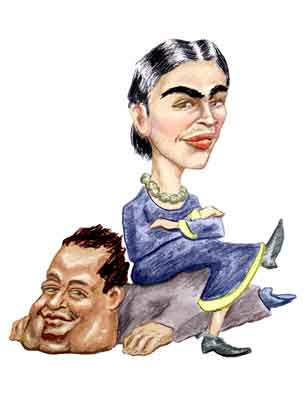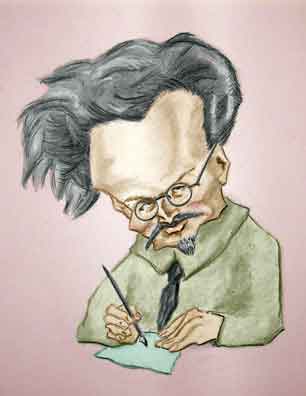Frida Kahlo and Diego Rivera

Frida Kahlo and Spouse
In the early Twentieth Century, one of the most famous contemporary artists was the Mexican muralist, Diego Rivera. Diego's career had a meteoric rise due in large part because 1) his well-to-do family had the right connections to get him started, and 2) he produced very good work which attracted attention of the right people in right circles.
Like many of the artsier men of the era, Diego was 1) politically to the far left - very far left - and 2) something of a tom cat. After two failed marriages, he met and married Magdalena Carmen Frida Kahlo y Calderón. Frida at the time had been painting for a number of years, although she didn't have the traditional formal training Diego did.
As a young girl, Frida had contracted polio. It's been stated that afterwards she was never in good health, but that's only partly true. Although at first she walked with a limp, her doting father would take her on excursions to Mexico City's many parks. Eventually she not only regained her strength but became quite the feisty young lady. As for her later health problems, they were not directly due to the polio.
Frida's father was a Hungarian immmigrant named, Carl Wilhelm Kahl, who Spanishized (if that's a word) his name by dropping his first name, taking the Spanish equivalent to his second, and adding an "o" to his last. Guillermo married the rather stern (and if the stories are true somewhat unpleasant) Matilde Calderón, and their third daughter was Frida. Guillermo accepted the invitation of his father-in-law to join him in his photography business, and he became one of the better known Mexican photographers.
With her father's blessings and her mother's objections, Frida enrolled in Mexico's National Prepartory School. At that time, a very good high school and a college were often indistinguishable, and she fit in quite well with a group of kids known as Las Cachuchas. This was, in essence, a gang of troublemakers, and eventually Frida was expelled. She then went (so the story goes) directly to the Ministry of Education and complained of the injustice. The Minster wrote to the principal that if he couldn't deal with such a forthright young lady he had no business running the country's most prestigious secondary school. So Frida returned to her studies.
The school had hired the even-then famous painter Diego Rivera to paint a mural in the auditorium. For some reason which her friends found incomprehensible, the lithe, thin, fifteen year old Frida was infatuated with the 36 year old, 300 pound, and quite flabbly Diego. She would watch him at work, teasing him about his girth and his girlfriends (even then Diego was known as a man who dipped his paintbrush in different colors). Once she soaped the steps to make Diego slip. However, due to his heftiness Diego walked deliberately and carefully, and it was one of the professors who fell down the stairs. In short, Diego more or less ignored the little pest, and when he finished with the job, he went on about his business.
Although today traffic in Mexico City is among the worst in the world, in Frida's day you could get into town and back quite easily via public transportation. Like teenagers everywhere she liked getting away from her parents, and when she was eighteen, she and her boyfriend were riding a bus when it collided with a street car. It was a horrible accident, and although her boyfriend escaped virtually unscathed, Frida suffered multiple broken bones (incluing fractured vertabrae) and internal injuries (including being impaled on a metal rod). Even today such injuries could easily be fatal, and in that era it was a miracle she survived.
Frida's dad painted as a hobby and as Frida recovered in bed she asked her dad if she could borrow his paints to pass the time. She showed a natural facility for detail and fine brushwork, and she began to paint in ernest. Once she got well enough to get about, she was walking along when she saw her former acquaintance Diego Rivera at work on a mural. She stopped and asked him to visit her home and render a verdict on her art. Diego, seeing Frida (whom he remembered) was no longer the immature, teenage escuincla she had been, accepted the invitation. After seeing her paintings Diego was encouraging, and evidently so was Frida. They got married in short order. Frida was 22; Diego was over forty.

Leon Trotsky
A Little Tit for Tat
It was the accident, not the polio, that ruined Frida's health. As a young woman she was able to manage all right, but as time went on she became increasingly fragile. She underwent a number of operations which may have made things worse. Sometimes she had literally to be carried from one place to another, and her painting was often done from a wheelchair. Still she managed to make extended trips with Diego, including considerable time in the United States.
Frida hated the United States, partly because (to be honest) there she was always Diego Rivera's wife, but also because her communist sympathies were appalled by the rampant greed that was everywhere. Diego, though, loved the Land of the Free and the Home of the Buck. He was a wined and dined and landed one commission after another, often paid for by the very capitalist denizens he and Frida (in principal) despised. So although Diego would have been happy to stay in the US indefinitely, Frida pushed for a return to Mexico City, and eventually they did.
But Diego was still a tom cat, and Frida repaid her wayward husband with a little kit-for-kat. One of her more famous boyfriends was the reasonably elderly Leon Trotsky, who was exiled from Russia and ended up in Mexico. Naturally Leon sought out the most famous communist artist in the world and he even took up residence at Casa Rivera. So it was all the more easy for Frida and Leon to get along quite well, so to speak. Frida also had girlfriends, as one particular film clip makes abundantly clear.
After Frida and Diego finally returned to Mexico, she continued to paint, and once the American film star Edward G. Robinson came to visit. When he saw Frida's paintings he immediately bought four of them for $200 each - very equitable pay for the time. Soon art dealers took interest and began exhibiting her work in their galleries in the US and Europe. Her paintings sold quite well, despite their rather macabre tone, and soon Frida was able to manage financially independently of Diego. Having enough of Diego's philandering, she had divorced him in 1940. However, neither could really get by without the other, and they remarried a year later, just accepting they'd have to put up with each other's peccadillos.
By mid-century Frida was increasingly infirm, and in 1953, gangrene set in her right leg. She had to undergo an amputation and died the next year at age 47. Diego followed three years later. He was 70.
Frida's early exhibitions and financial success notwithstanding, she remained largely unknown to the international public. Although many people in the mid-Twentieth Century knew of Diego Rivera as the greatest muralist of the Twentieth Century, few knew of Frida or her work. But when the art mania began in the 1980's (where millionaires could spend $80,000,000 for a possibly forged Van Gogh, and now hospitals can resell paintings purchased for $200 for $68,000,000), Frida's paintings were rediscovered, widely exhibited, and books on her life were written. Suddenly Frida switched from being Diego Rivera's wife to Diego being Frida Kaho's husband.
¡Lo siento, Diego!